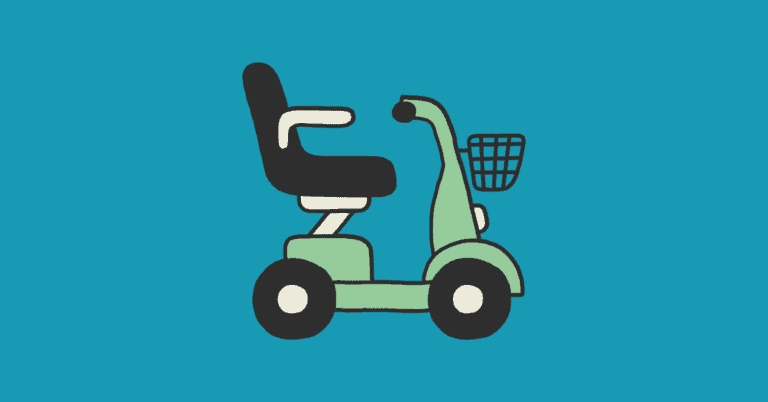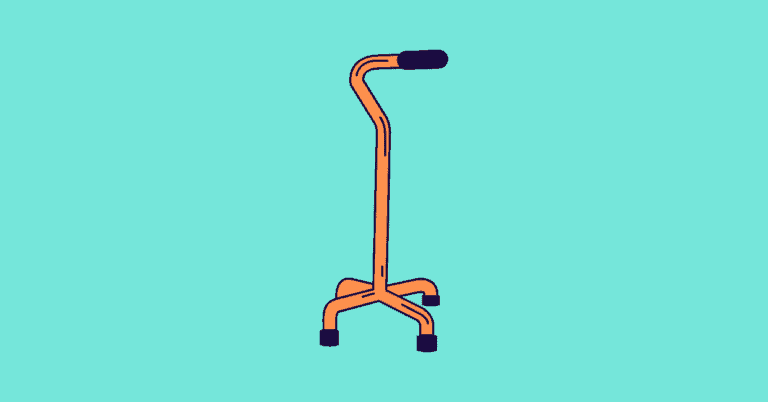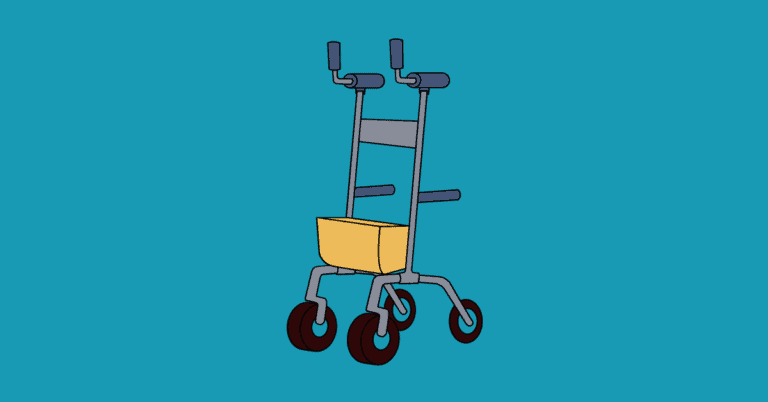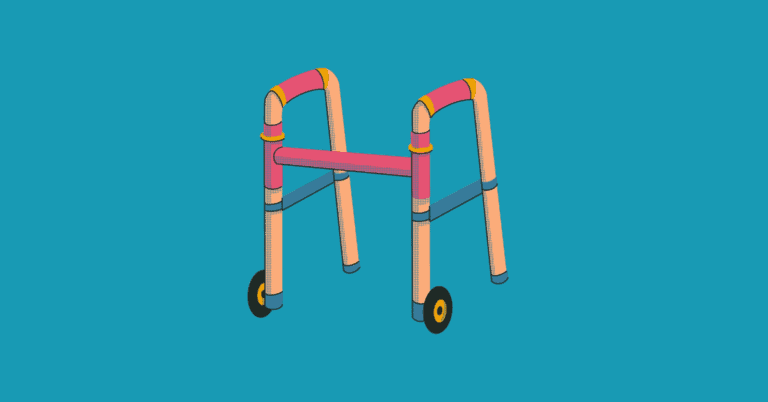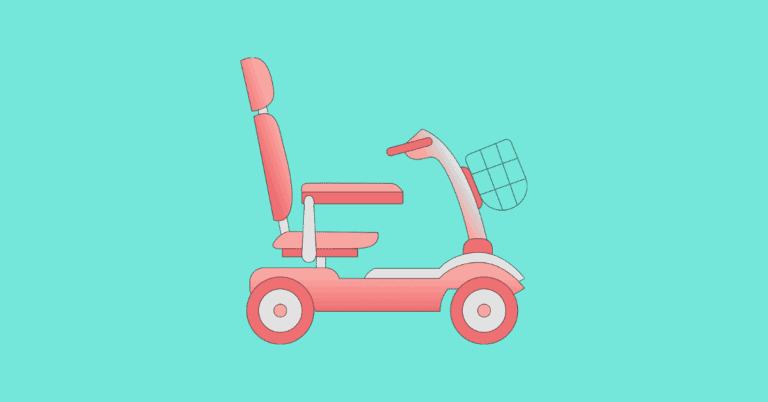Best Rollator Walker With Seat: 5 Great Options
Struggling to find the best rollator walker with seat that suits your needs?
You’re not alone.
The world of assistive devices has seen a surge in popularity, with rollators becoming an increasingly common choice among individuals seeking mobility and walking aids.
Ordering one online is a breeze, but the real challenge lies in selecting the right one from the myriad options available.
That’s where I come in. This article simplifies the process for you by narrowing down the top 5 rollator walkers with seats, based on individual requirements.
The Run Down In a Few Words:
- Best adjustable rollator: Zipr Pioneer
- Best lightweight and affordable rollator: McKesson Lightweight
- Best compact rollator for shorter individuals: Carex Probasic
- Best heavy duty or bariatric rollator: Drive Medical
- Best upright rollator: Vive Health
This above “best for” list is not an all-encompassing, exhaustive overview but if I only had a few words to describe which rollator may be best for you, above is what I would say. That said, I suggest further exploration based on your specific requirements and preferences. For example, it is conceivable that a shorter person might find the Zipr rollator more suitable than the Carex, despite the Carex being specifically designed for petite individuals.
How were these rollators selected?
Drawing on my background working in Physical Therapy clinics, I’ve had the opportunity to work closely with individuals requiring assistive devices, providing me with a good understanding of what truly matters in a rollator.
In curating this list of the best rollators, I relied on a blend of my professional insights and the valuable feedback from users like you.
The focus was on identifying rollators that excel in key aspects – ease of maneuverability, personalized adjustability, sturdy physical build, and reasonable cost.
These factors, grounded in real-world considerations, guided the selection process to ensure practical solutions for your mobility needs.
What is the Best Rollator Walker With Seat?
Here is a summary table of the specifications:
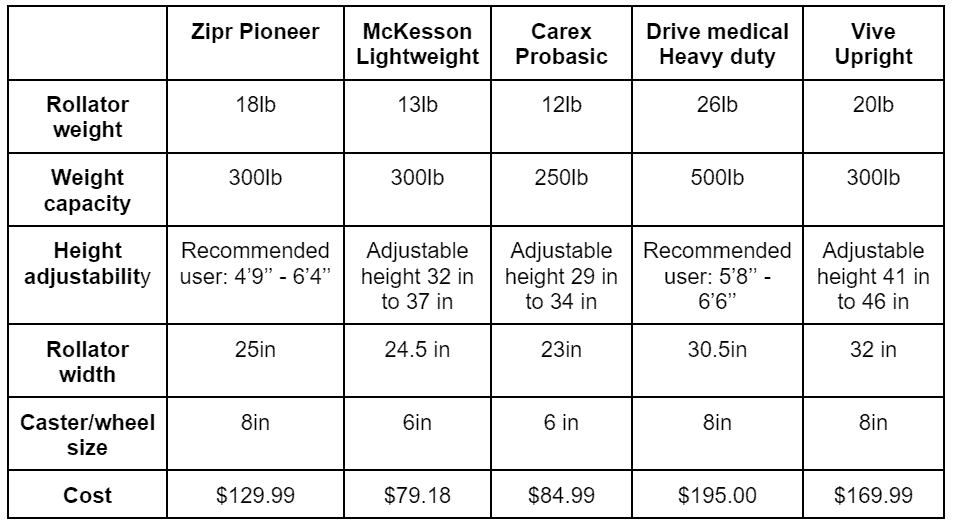
Don’t worry, you’ll be seeing this table a lot more throughout the article for reference.
Note that the ‘height adjustability’ category varies among rollators. Some models specify recommended user heights, while others provide length measurements from the ground to the handles.
Given the natural differences in the ratio of arm length to height among individuals, it’s challenging to definitively state whether a rollator will perfectly accommodate your height. Typically, most rollators are designed for the average population height, so they should generally suit your needs.
If you have concerns, you can measure your height from the ground to your wrist (with your hand relaxed by your side) for a more personalized assessment. Ideally, you want the handle of the rollator to be at a level that results in a slight bend in the elbow when you grip it.
Another note, all of these rollators have:
– A seat
– Are foldable (and can be easily stored in a car trunk)
– Include back rest support when seated
– Come with storage options (like basket or bag).
– Have hand and lock brake systems (loop brake system: push up to break, and push down to lock), which is a must for safety (see below)

Read on for more details on each rollator!
1. Zipr Pioneer Rollator Walker with Seat

Overview
The Zipr pioneer rollator walker is one of the most height adjustable walkers on this list. Its aluminum frame is noted for its sturdiness. Additionally, it’s a good option for both indoor and outdoor use, which adds to its adaptability. Assembling this rollator is a breeze, adding to its user-friendly design.
Overall, the rollator is highly praised, and I don’t say that lightly; It is a reliable option for those seeking a walker that prioritizes adjustability and functionality without unnecessary embellishments.
Specifications

Top Features
- While it is moderate in weight when compared to the rollators on this list, 18lb is a relatively low rollator weight.
- Biggest height adjustable range
- Great for indoor and outdoor use → good maneuverability over uneven terrain.
- Sturdy
- Easy to assemble and fold
- Includes removable storage bag and cane holder
Considerations
- The benefit of 8in wheels is that it can be good for outdoor use over uneven terrain and to overcome obstacles, but it may be harder to navigate in tight spaces (in comparison to 6in wheels).
- Since the rollator width is 25in, this should be fine to fit through most doorways. However, if you are concerned about certain spaces in your household, consider measuring those specific areas to ensure the rollator can navigate through comfortably.
Cost
$ 129.99
2. McKesson Lightweight Rollator Walker with Seat

Overview
The McKesson Lightweight rollator stands out as one of the most lightweight and affordable rollators available, making it a popular choice for among users that have a hard time lifting heavier objects. It’s also easy to fold, which adds to the portability. This feature enhances its practicality for individuals seeking a rollator that can be effortlessly transported and stored when not in use.
Particularly, this rollator is well-suited for navigating tighter, narrower indoor spaces.
The combination of affordability, lightweight construction, and user-friendly features positions the McKesson Lightweight walker as a reliable and convenient mobility aid.
Specifications

Top Features
- Lightweight
- Affordable
- Great for navigating narrow spaces and corners (smaller turn radius)
- Folds easily
- Includes storage pouch and padded seat
Considerations
- The height is adjustable from 32in to 37in, which likely suits users from 5’1 to 6’4’’. While individual variations in hand length to height ratio exist, it is made to fit most individuals. You can confirm by measuring from hand by your side to the ground.
- While the 6in wheel size makes it great for navigating tight spaces, it might be harder to navigate outdoor uneven sidewalks and surfaces compared to the other rollators on this list.
- Rollator seat width is 14 in. If this is too small for you, consider other options.
Cost
$84.99
3. Carex Probasics Junior Rollator

Overview
The Carex ProBasics Junior Rollator is a standout option for individuals of shorter heights, offering a lightweight design that prioritizes both ease of use and maneuverability.
This rollator excels in navigating tight spaces and corners, thanks to its smaller turn radius. Beyond its design, it distinguishes itself as the most affordable rollator on this list, making it an accessible choice for users seeking cost-effective mobility solutions without compromising on quality and functionality.
This rollator is similar to the Mckesson — with its emphasis on compactness, lightweight construction, and affordability, except that Carex probasic can accommodate shorter people.
And based on the feedback of users within the supported height range, they love this rollator!
Specifications

Top Features
- Perfect for shorter individuals. With adjustable height from 29 in to 34 in, it will likely accommodate users of 4’8’’ to 5’5’’ heights.
- Lightest rollator on this list
- Most affordable rollator on this list
- Great for navigating tight corners and spaces due to small turn radius
- Compact size rollator with width of 23 in, so should have no problems going throughout most doorways
- Includes water resistant storage bag
Considerations
- Weight capacity is 250lb, which is less than other rollators
- While 6-inch wheel size make it great for confined spaces, it may be harder to navigate outdoor uneven surfaces compared to other rollators on this list
- The rollator seat width is 13.5 in, which may be too narrow for some
- Individuals more than 5’5’’ height may have to consider other options
Cost
$74.99
4. Drive Medical Go-Lite Heavy Duty

Overview
The Drive Medical go-lite heavy duty rollator, as suggested by the name, stands out as a great heavy duty rollator, suitable for bariatric populations. With sturdy construction and height adjustability, it also works for taller individuals.
It does well in navigating uneven, outdoor terrain – providing a reliable and stable mobility solution for various environments.
Overall, this rollator not only excels as a solid option for bariatric populations but also offers versatility for taller individuals, ensuring a comprehensive solution for users seeking stability and maneuverability across different terrains and environments.
Specifications

Top Features
- Great for bariatric population and tall individuals (5’8’’ to 6’6’’)
- Does well with navigating uneven outdoor terrain
- Sturdy-built offers a huge weight capacity of up to 500 lb
- Comes with a basket for storage
Considerations
- Rollator is on the heavier side
- Rollator width of 30.5 in, so may be harder to fit through some doorways. If concerned, you can measure the doorways in your house
- May be harder to navigate narrow corners and spaces
Cost
$195.00
5. Vive Health Upright Rollator – Walker with Foldable Transport Seat
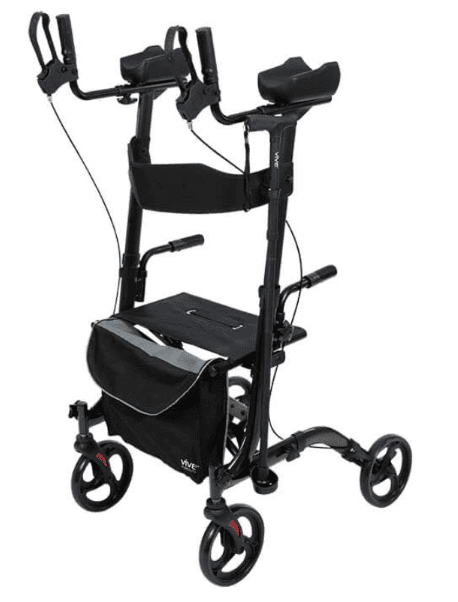
Overview
If you are looking for an upright rollator, Vive Health upright rollator is an excellent option. In an upright rollator, you rest your forearms on the armrest, which is intended to help achieve a more upright posture. Due to this, it can also be more beneficial for someone with hand or wrist pain and weakness.
Unlike traditional rollators, upright rollators generally allow the user to stand closer within the walker, which can help provide more stability for some.
Beyond its ergonomic design, the Vive Health Upright Rollator is good for navigating uneven outdoor terrain, such as uneven sidewalks, ensuring users have a versatile mobility aid for various environments.
Specifications

Top Features
- Great for navigating uneven outdoor terrain
- Can encourage a more upright posture
- For an upright rollator, 20lb weight is fairly reasonable
- Adjustable handles: length of handles extending from the armrests are adjustable
- Includes a storage bag
Considerations
- Height is adjustable from 41 inches to 46 inches (this is the height from the floor to the armrest, where your forearms would rest), which is meant to accommodate individuals from from 5’ to 6′ 2’’ . In this case, you can measure from your elbow to the ground to get an idea of whether it’s the right fit for you.
- The rollator width is on the wider side (32in), so may have trouble getting through narrow doorways. If you are concerned, I suggest measuring the doorways in your home to ensure it will fit without issues.
- Larger turn radius with the 8in wheels so may be harder to navigate small spaces and tight corners.
Cost
$169.99
Rollators FAQ
What do all these rollators have in common?
Like mentioned above, all of these rollators have a seat, backrest (when seated), some sort of storage option for personal items (like a bag or a basket), are foldable (allow easy storage), and come with hand and lock brakes.
Are smaller or bigger wheels better on a rollator?
Generally the size of wheels on a rollator tend to range from 6 inches to 10 inches.
Rollators with smaller wheels are preferable for indoor use as they provide a smaller turn radius, making it easier to navigate tight corners and spaces. On the other hand, rollators with larger wheels, while having a larger turn radius, are better at handling uneven and rougher terrain, offering a smoother ride in outdoor environments.
The choice between smaller or bigger wheels depends on the user’s specific needs and the intended usage scenarios, whether it be primarily indoors or outdoors.
How do the breaks on the rollator work? Lock breaks?
The hand brakes use a loop brake system.
Similar to a bicycle, you would pull the hand brakes up to brake while walking with the rollator.
To temporarily lock the rollator (such as before and while sitting), you would pull the hand brakes down, and this will cause it to lock; To note, you do not have to hold the hand brakes down, it should stay in place on its own. To unlock, slide the brake handles back up.
What is the difference between a rollator and a regular walker? A rolling walker? A three-wheeled rollator?
A rollator and a regular walker, including a rolling walker and 3-wheeled walker, differ in their design and features.
A standard rollator has four wheels, a frame with a seat, and hand brakes. It offers more stability and support than a regular walker, and users can sit on the attached seat when needed.
Regular walkers have a simple frame with no wheels and are lifted and moved with each step. A rolling walker is a version of a regular walker with two front wheels, so instead it doesn’t need to be lifted, you can slide it to move. Walkers are lighter but provide less support and control than rollators.
A three-wheeled rollator is a variation of a rollator with three wheels, providing more maneuverability in navigating narrow spaces and taking sharp turns but may offer less stability compared to a four-wheeled rollator. There aren’t any 3-wheeled rollator options on this list because they do not come with a seat due to the shape.
The choice depends on individual mobility needs and preferences.
What is the difference between a standard rollator and an upright rollator?
An upright rollator is designed to promote a more erect posture by featuring forearm supports or armrests. Users of upright rollators can rest their forearms on these supports, encouraging a straighter posture during use.
Even so, this doesn’t necessarily mean that a regular rollator encourages a forward leaning posture.
However, in a standard rollator, the base of support can be further from you, potentially leading to a more forward-leaning posture over time (if you are not conscious of your posture). With an upright rollator, you are walking more closely within the walker and hence, the base of support.
That said, due to its design and greater width, upright walkers tend to have a larger turn radius and may be harder to navigate in tight spaces and through narrow corridors.
Is a rollator better for balance than other assistive devices?
If there was a very basic hierarchy of balance support among different walking assistive devices, it would be a cane, regular/rolling walker, and finally a rollator.
A cane is the most minimalist aid, suitable for light assistance, followed by a regular/rolling walker offering more stability. A rollator, being the most supportive among the three, is recommended for individuals with greater balance deficiencies or those at greater falls risk.
Additionally, the inclusion of the seating option in a rollator highlights its suitability for individuals with lower walking endurance, allowing them to take breaks as needed.
Of course, this isn’t accounting for other assistive devices such as electric wheelchairs or mobility scooters.
Will Medicare cover the cost of my rollator?
Medicare Part B serves as supplementary medical insurance, providing individuals the option to opt out if they choose. For those enrolled in Medicare Part B, assistive devices like rollators fall under the durable medical equipment (DME) category.
However, it’s important to understand that reimbursement for specific assistive devices comes with specific eligibility criteria. So, not everyone may qualify for Medicare reimbursement due to the complexity of rules and procedures.
Navigating the reimbursement process for your assistive device involves a series of steps, which can vary in order and specificity. Typically, for those considering an assistive device through Medicare Part B, it begins with a doctor prescribing the device as a medical necessity. Following the prescription, the next step is to coordinate with a certified occupational therapist, physical therapist, or a Medicare-approved assitive device supplier. Your therapist may also have recommendations for approved suppliers, making the process more accessible.
The collaborative assessment by your therapist aims to understand your mobility needs, medical condition, and lifestyle requirements. This forms the basis for accurate form submissions to Medicare. The time it takes to obtain your assistive device varies based on factors such as the extent of customization required.
It’s important to note that Medicare covers the basic level of DME products for specific conditions. When you need new equipment, your doctor must provide documentation stating its medical necessity for your condition. Understanding these steps and working closely with your healthcare team can facilitate a smoother process for obtaining the necessary assistive devices through Medicare.
What are other types of assistive device options?
- Wheelchairs:
- Manual Wheelchairs: Rolling speed is determined by the user since it is manually propelled (or a caregiver can provide help).
- When deciding between an electric wheelchair and a manual one, a key distinction arises in the requirement for upper body strength and endurance.
- Some individuals choose a manual wheelchair not only due to their physical capability but also for the flexibility it provides. For instance, manual wheelchairs are characterized by lower maintenance, increased portability due to their lightweight nature, and, in certain scenarios, better adaptability for navigating uneven surfaces and terrains.
- Electric Wheelchairs: Powered by batteries, these offer greater independence and are suitable for individuals with limited upper body strength.
- As an advanced assistive device, electric wheelchairs provide substantial support, especially for individuals dealing with lower limb paralysis or conditions affecting muscular health and voluntary movements.
- Manual Wheelchairs: Rolling speed is determined by the user since it is manually propelled (or a caregiver can provide help).
- Canes:
- Standard Canes: A light weight support for individuals with mild balance issues.
- Quad Canes: Feature a four-point base for increased stability.
- Offset Canes: Designed to align the user’s weight directly over the shaft for improved balance.
- Crutches:
- Underarm/axillary Crutches: Fit under the arms and are suitable for temporary mobility challenges.
- Axillary crutches are commonly employed as temporary mobility aids during recovery phases, such as post-operative periods, injury rehabilitation, or whenever assistance with non-weight bearing is essential.
- Forearm Crutches: Provide support at the forearm, offering a more ergonomic option.
- Underarm/axillary Crutches: Fit under the arms and are suitable for temporary mobility challenges.
- Mobility Scooters: Typically, mobility scooters are designed for individuals capable of short-distance walking but in need of support for more extended excursions or experiencing challenges with prolonged standing.
- Travel Scooters: Compact and easily transportable for use in various settings.
- Heavy-Duty Scooters: Designed for rugged terrain and longer distances.
- Walkers:
- Standard Walkers: Provide basic support for walking.
- Rolling Walkers: Equipped with wheels for easier maneuverability.
- Rolling walkers, featuring two front wheels, eliminate the need to lift the walker off the ground with each step. These walkers are frequently among the most commonly provided assistive devices following surgery during hospital recovery.
When considering assistive devices, it’s crucial to assess individual needs, taking into account factors like the user’s mobility level, lifestyle, and any specific health conditions. Consultation with healthcare professionals can help in making informed decisions about the most suitable assistive devices.
Bottomline — So, what is the best rollator?
You know the answer to this question. All the rollators on this list are solid options.
There is no one best rollator because it all depends on your priorities and needs – whether that be a lightweight design, robust support, maneuverability, or additional features like an upright posture design.
